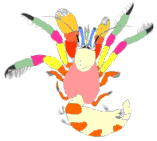
Calcinus haigae Wooster, 1984
Illustrations. - • Male shield length 2.3 mm, Tuamotu. • Specimen from Hawaii (copyright J. Hoover). After Hoover 1998. • Ocular peduncles, color pattern. • Left third pereopod, color pattern.
References. - Calcinus haigae Wooster, 1984: 146 (type locality, Mariana).
Calcinus haigae - Haig & McLaughlin, 1984: 110, 114 (Hawaii). - Morgan, 1991: 880, figs 17–20 (Cocos Island; Australia). - Gherardi & McLaughlin, 1994: 619 (Mauritius; =? C. rosaceus, cf. Remarks).- Poupin, 1997: 695 (Tuamotu). - Debelius, 1998: 278 (Red Sea; color photograph). - Hoover, 1998: 254 (Hawaii). - McLaughlin & Hogarth, 1998: not seen (Seychelles). - Hogarth et al., 1998: 155 not seen (Maldives). - Asakura & Tachikawa, 2003: 719 (Caroline Is.; Tuamotu; Cocos-Keelings; Seychelles). - Poupin & Lemaitre, 2003: 15 (Austral and Tuamotu, French Polynesia; Ponape, Caroline Is.; American Samoa).
Shield and cephalic appendages. - Ocular scale with several terminal spines (2–5 spines, usually 3).
Chelipeds (P1). - Upper margin of right chela tuberculated or spinous. Outer face of left palm regularly convex.
Ambulatory legs (P2-P3). - Dactyl of P3 subequal to propodus or slightly shorter. Distal pilosity of P3 weak, similar to distal P2.
Armament of telson. - Left lobe of telson with several spines disposed on posterior margin only (5–9). Right lobe with several spines (3–6).
Coloration. - Shield purple-brown. Ocular peduncle multicolored with narrow ring close to cornea. Detailed coloration of ocular peduncle: brown, burgundy or purple, with narrow white ring close to cornea. Distal antennular peduncle blue or dark blue (basal segments black; flagella grey). Distal antennal peduncle brown (to purple-brown; flagellum pale brown). Chela uniformly colored, often grading to paler distally (purple-brown turning to cream; carpus of cheliped dark brown). Ambulatory legs (P2 & P3) with spots (purple-brown background, with scattered orange spots distally; tip of dactyl white).
Habitat. - Facultative associates of corals (e.g. Pocillopora, Acropora), shallow-waters (common at depths of 6 m or more (40 m) in heads of branching coral or on rocky substrate).
Geographic distribution. - Maldives, Seychelles and Mauritius (see remarks); Cocos Island, western Australia; Mariana; Hawaii; Caroline Is.; American Samoa; French Polynesia, Austral and Tuamotu. Indo-West Pacific.
Remarks. - Calcinus haigae is closely related to C. rosaceus Heller, 1861 known from east Africa and Red Sea and with almost the same coloration. Unfortunately, the status of C. rosaceus remains unclear and collection of fresh specimens are needed to clearly separate the two species. If they really are distinct taxa, then specimens of C. haigae recorded from Mauritius (Gherardi & McLaughlin, 1994) could in fact belong to C. rosaceus.
Additional remark, April 2004
In Asakura & Tachikawa, 2003: 729, specimens of C. rosaceus from Red Sea (coll. 1968 & det. Lewihsohn TAU-NS 4774) and C. haigae from Seychelles (coll. 1992, RMNH-D 47845) have been compared. The difficulty to separate C. haigae and C. rosaceus is discussed. The conclusion is that C. haigae would be present in Mauritius, Seychelles and Maldives but that fresh material from these places is clearly necessary to confirm that point. In any case, the only reliable diagnostic color pattern for separating preserved material of the two species is the presence of spots on P2 and P3 in C. haigae, which are lacking in C. rosaceus (see photograph published by Debelius, 1998: 278).